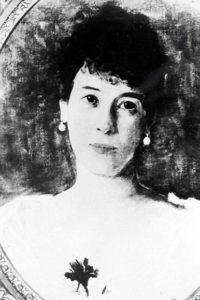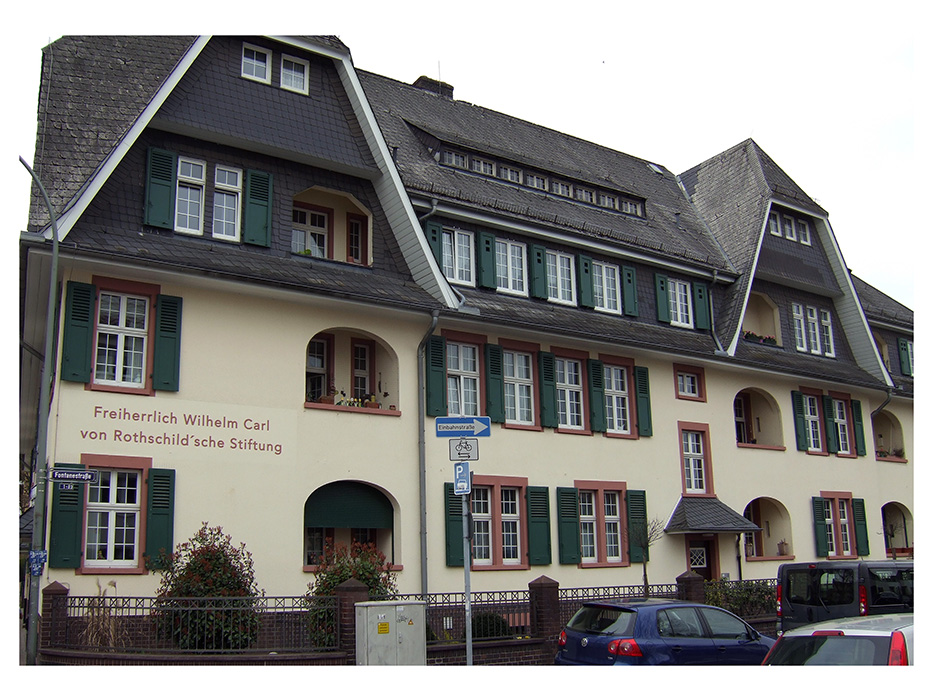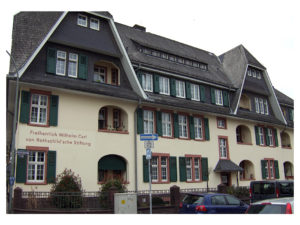
© Courtesy of the Leo Baeck Institute (Paul Arnsberg Collection)
Shortly before her death, the Frankfurt Jewish foundress Minka von Goldschmidt-Rothschild turned the Zedaka (Jewish commandment of social justice through charity) into reality, when she initiated the construction of a larger rental complex for materially deprived, widowed or unmarried women of all denominations. Her mother Mathilde von Rothschild and her sister Adelheid de Rothschild who lived in Paris after her marriage, as well as Minka´s husband Max von Goldschmidt-Rothschild and their daughter Lily Schey von Koromla took charge of the extensive social residential project.
The „Residential Home for Ladies” of the Baron Wilhelm Carl von Rothschild Foundation for Charitable and Non-Profit Purposes at Hügelstrasse 142-146

© Edgar Bönisch
Also in Frankfurt am Main construction of social housing did not regain momentum until the 1920’s. Before that time, especially single older women in Frankfurt with a low income had difficulties in finding an affordable and suitable home. Due to being the fact they they were hardly represented in the tenant-rights movement of the German Empire, they were exposed to increasing rents, termination of rental agreement without notice and harassments by some landlords. Even though having grown up prosperously, the foundresses of the Frankfurt banking family Rothschild were sensitive to these needs: In 1902 Minka von Goldschmidt-Rothschild established the Baron Wilhelm Carl von Rothschild Foundation for Charitable and Non-Profit Purposes in memory of her deceased father, among other things with the intention to create affordable housing for low-income female Frankfurt citizens. She signed the Foundation Statute, which she seemed to have written for the most part on her own, on 29th October 1902: “As a symbol of pious memory, which I, Mrs Max Goldschmidt, née Baroness von Rothschild, will ever keep for the city, where the ancestral home of my family is, I have decided to establish a foundation to the memory of my blessed father, Mr Wilhelm Carl Baron von Rothschild, which is meant to give this mindedness an outward expression. In order to obtain the rights of a legal entity for this foundation I have compiled the following statute” (quoted by the Statute of Rothschild´s Residential Home for Ladies 1904, page 1, highlighting B.S.)
A significant part of the extensive foundation was the purchase or construction of residential houses with inexpensive and separate small-apartments for Jewish and non-Jewish “less well-off women or girls of the middle class” (see page 2). Also the foundation board, whose initial members were Mayor Dr. Adickes, Counsellor of Health Dr. Marcus and Town Councilor Dr. Woell, was to be filled “irrespective of denomination” (see page 4). In 1910, seven years after Minka von Goldschmidt-Rothschild´s early death, the objective of the foundress was achieved and a large building complex erected at Hügelstrasse 142-146 in the Eschersheim district. Part of the property of the Residential Home for Ladies were the houses at Fontanestrasse 1-3 and Klaus-Groth-Strasse 81-83. What had been created was an interdenominational residential home for single senior ladies not in need of nursing care, which fulfilled the function of a home for pensioners at the same time.
In 1911 ladies could move into the building complex with 23 unfurnished one- and two-room apartments, equipped with mansards, basement, kitchen, initially a dining room as well as the flat of the property manager (cp. ISG Ffm, magistrate records V / 538 volume 3). Many of the female tenants, mainly widows of former members of the middle class, older female single teachers and social pensioners, used the possibility of having a free lunch offered in town. After the First World War Rothschild´s residential project was also affected by inflation (cp. Meyerhof-Hildeck 1923), however, it kept on providing reliable shelter. In contrast, during this time of crisis older private tenants who lived on their own increasingly feared they would lose their own four walls and independence by being referral to a retirement home. At the beginning of the 1920’s the Professor´s wife Marie Wachsmuth made herself available as a voluntary welfare worker and contact person for the Frankfurt welfare office. The files (cp. ISG Ffm: welfare office sign. 326) of the welfare office contain the names and data of some residents such as Marie Demuth (born in Frankfurt/M. in 1855), Wilhelmine Schwarz (born in Frankfurt/M. in 1854), who was paid an annuity from a previous employment and Margarete Stolzenhain [Margarethe Stolzenhayn] (born in Berlin in 1865), who was also classed as a needy person. An indication of Jewish tenants in the Residential Home for Ladies is given by the Jewish community newsletter for Frankfurt am Main, which announced the 70th birthday of the Jewish community member Rosette Goldschmidt, resident at Hügelstrasse 144. Certainly, this woman who was a native of Frankfurt had had to move out of the house in which she lived, which was mainly inhabited by non-Jewish residents, due to the anti-semitic NS-“Law on Tenancies with Jews”, which was enacted on 30th April 1939, abolishing the protection against eviction and forcing the spatial separation from non-Jewish neighbors. Rosette Goldschmidt´s last address was the Jewish Retirement Home Niedenau 25 (transit camp) from where the 74-year old pensioner was deported to Theresienstadt on 18th August 1942 and from there to the extermination camp Treblinka on 23rd September 1942 (cp. JM Ffm: database).
The National Socialists intended to wipe out all memory of the extensive philanthropic commitment of Frankfurt´s Jewish founder family Rothschild which was why they renamed the funding body to “Foundation for Charitable Purposes (Housing Assistance Foundation)”. In 1940 the Aktienbaugesellschaft für kleine Wohnungen (joint stock corporation for construction of small residences) “purchased” the building complex for small apartments. It was returned to the legal owner family four years after the end of the NS-regime (cp. Lenarz 2003) followed by re-establishing the foundation as “Baron Wilhelm Carl von Rothschild´s Foundation for Charitable Purposes” in 1950. Entirely in line with the intention of the initiator Minka von Goldschmidt-Rothschild, the social housing project assists needy pensioners up to the present day– and is, as a frail elderly tenant (she is from Odessa / Ukraine) told us, still a “residential home for ladies”.
Birgit Seemann, 2013, updated 2017
